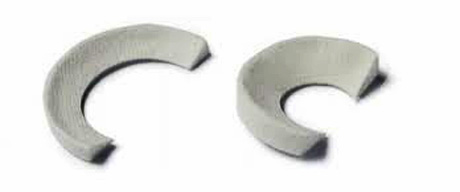ARTIFICIAL MENISCUS IMPLANTATION

Synthetic or Collagen meniscal implant
Treatment of meniscal lesions is the most common surgical intervention performed by orthopaedic surgeons today.
In previous years as today in tears of the meniscus partial or subtotal meniscectomy was the only solution. The deduction, however, part of the meniscus is essentially removing a significant factor in protecting the articular cartilage causing premature wear this for two reasons:
• create the development of large focal power between the femur and tibia cartilage in point deficit and meniscus
• grow bigger and paradoxical movement of the bone between them.
Although repair of meniscal lesions is the preferred treatment, this is not always possible, particularly for
lesions in the avascular portion of the meniscus. For such irreparable lesions, partial meniscectomy is the current
standard of care.
This involves removing the unstable fragments of the torn meniscus and contouring the remaining
frayed meniscal edges while preserving as much of the meniscal structure as possible.
The evolution of biotechnology synthetic grafts or collagen graft and the refinement of arthroscopic techniques and tools, provided an opportunity today to specialized orthopedic surgeons to perform transplants meniscus (synthetic or allograft) restoring thereby the deficit left by the excision of the meniscus avoiding premature damage and the development of osteoarthritis.
After a lengthy investigation, in cooperation with leading experts, created a synthetic scaffold of the meniscus, which is the next step in surgery of the knee.
Synthetic meniscus is a resilient, flexible, highly porous, biodegradable and biocompatible synthetic scaffold. It is a honeycomb like structure, through which blood vessels can rapidly grow. The blood transports cartilage repair cells and other nutrients that initiate the growth of new meniscus-like tissue.
The meniscal scaffold is placed in the patient’s knee at the time of partial meniscectomy using a standard
arthroscopic surgery procedure and standard equipment.
It is intended for use in the treatment of irreparable, partial meniscal tissue defects in order to reduce pain and restore compromised functionality by reinstating the load-bearing and shock-absorbing capacity of the meniscus.
CONCLUSIONS
• Safe
• Statistically and clinically significant improvements in all patient outcomes at 6,12 and 24 months
• All efficacy scores continue to improve between 12 and 24 months
• In KOOS the largest improvements are seen in the Sports and Quality of Life subscales
• The Polyurethane Scaffold supports tissue ingrowth with meniscus-like characteristics


